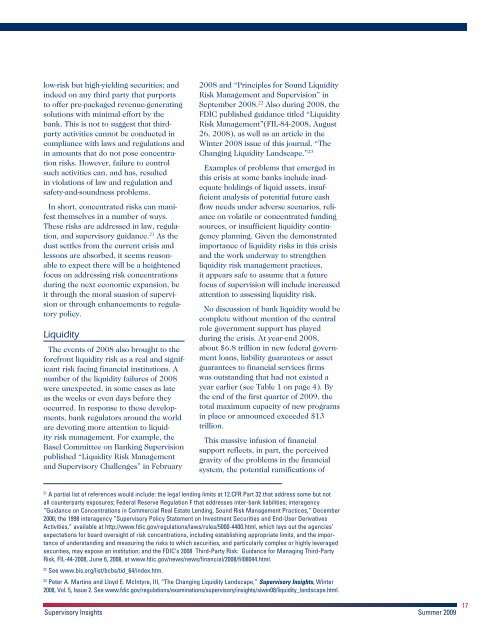FDIC Supervisory Insights Summer 2009
FDIC Supervisory Insights Summer 2009
FDIC Supervisory Insights Summer 2009
You also want an ePaper? Increase the reach of your titles
YUMPU automatically turns print PDFs into web optimized ePapers that Google loves.
low-risk but high-yielding securities; and<br />
indeed on any third party that purports<br />
to offer pre-packaged revenue-generating<br />
solutions with minimal effort by the<br />
bank. This is not to suggest that third-<br />
party activities cannot be conducted in<br />
compliance with laws and regulations and<br />
in amounts that do not pose concentration<br />
risks. However, failure to control<br />
such activities can, and has, resulted<br />
in violations of law and regulation and<br />
safety-and-soundness problems.<br />
In short, concentrated risks can manifest<br />
themselves in a number of ways.<br />
These risks are addressed in law, regulation,<br />
and supervisory guidance. 21 As the<br />
dust settles from the current crisis and<br />
lessons are absorbed, it seems reasonable<br />
to expect there will be a heightened<br />
focus on addressing risk concentrations<br />
during the next economic expansion, be<br />
it through the moral suasion of supervision<br />
or through enhancements to regulatory<br />
policy.<br />
Liquidity<br />
The events of 2008 also brought to the<br />
forefront liquidity risk as a real and significant<br />
risk facing financial institutions. A<br />
number of the liquidity failures of 2008<br />
were unexpected, in some cases as late<br />
as the weeks or even days before they<br />
occurred. In response to these developments,<br />
bank regulators around the world<br />
are devoting more attention to liquidity<br />
risk management. For example, the<br />
Basel Committee on Banking Supervision<br />
published “Liquidity Risk Management<br />
and <strong>Supervisory</strong> Challenges” in February<br />
2008 and “Principles for Sound Liquidity<br />
Risk Management and Supervision” in<br />
September 2008. 22 Also during 2008, the<br />
<strong>FDIC</strong> published guidance titled “Liquidity<br />
Risk Management”(FIL-84-2008, August<br />
26, 2008), as well as an article in the<br />
Winter 2008 issue of this journal, “The<br />
Changing Liquidity Landscape.” 23<br />
Examples of problems that emerged in<br />
this crisis at some banks include inadequate<br />
holdings of liquid assets, insufficient<br />
analysis of potential future cash<br />
flow needs under adverse scenarios, reliance<br />
on volatile or concentrated funding<br />
sources, or insufficient liquidity contingency<br />
planning. Given the demonstrated<br />
importance of liquidity risks in this crisis<br />
and the work underway to strengthen<br />
liquidity risk management practices,<br />
it appears safe to assume that a future<br />
focus of supervision will include increased<br />
attention to assessing liquidity risk.<br />
No discussion of bank liquidity would be<br />
complete without mention of the central<br />
role government support has played<br />
during the crisis. At year-end 2008,<br />
about $6.8 trillion in new federal government<br />
loans, liability guarantees or asset<br />
guarantees to financial services firms<br />
was outstanding that had not existed a<br />
year earlier (see Table 1 on page 4). By<br />
the end of the first quarter of <strong>2009</strong>, the<br />
total maximum capacity of new programs<br />
in place or announced exceeded $13<br />
trillion.<br />
This massive infusion of financial<br />
support reflects, in part, the perceived<br />
gravity of the problems in the financial<br />
system, the potential ramifications of<br />
21 A partial list of references would include: the legal lending limits at 12.CFR Part 32 that address some but not<br />
all counterparty exposures; Federal Reserve Regulation F that addresses inter-bank liabilities; interagency<br />
“Guidance on Concentrations in Commercial Real Estate Lending, Sound Risk Management Practices,” December<br />
2006; the 1998 interagency “<strong>Supervisory</strong> Policy Statement on Investment Securities and End-User Derivatives<br />
Activities,” available at http://www.fdic.gov/regulations/laws/rules/5000-4400.html, which lays out the agencies’<br />
expectations for board oversight of risk concentrations, including establishing appropriate limits, and the importance<br />
of understanding and measuring the risks to which securities, and particularly complex or highly leveraged<br />
securities, may expose an institution; and the <strong>FDIC</strong>’s 2008 Third-Party Risk: Guidance for Managing Third-Party<br />
Risk, FIL-44-2008, June 6, 2008, at www.fdic.gov/news/news/financial/2008/fil08044.html.<br />
22 See www.bis.org/list/bcbs/tid_64/index.htm.<br />
23 Peter A. Martino and Lloyd E. McIntyre, III, “The Changing Liquidity Landscape,” <strong>Supervisory</strong> <strong>Insights</strong>, Winter<br />
2008, Vol. 5, Issue 2. See www.fdic.gov/regulations/examinations/supervisory/insights/siwin08/liquidity_landscape.html.<br />
<strong>Supervisory</strong> <strong>Insights</strong> <strong>Summer</strong> <strong>2009</strong><br />
17

















